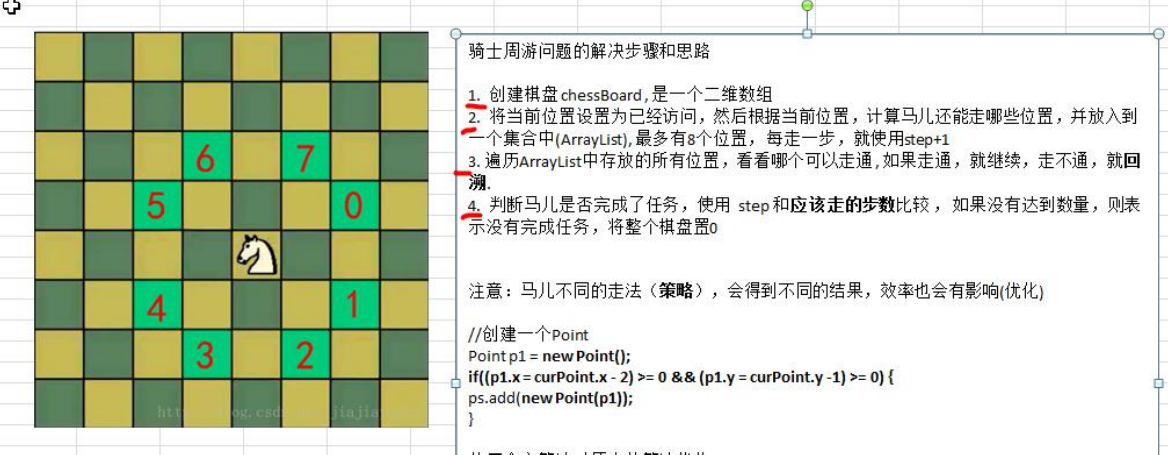1.马踏棋盘算法介绍和游戏演示
- 马踏棋盘算法也被称为骑士周游问题
- 将马随机放在国际象棋的 8×8 棋盘 Board[0~7][0~7]的某个方格中,马按走棋规则(马走日字)进行移动。要求每个方格只进入一次,走遍棋盘上全部 64 个方格
- 游戏演示: http://www.4399.com/flash/146267_2.htm

2.马踏棋盘游戏代码实现
- 马踏棋盘问题(骑士周游问题)实际上是图的深度优先搜索(DFS)的应用。
- 如果使用回溯(就是深度优先搜索)来解决,假如马儿踏了 53 个点,如图:走到了第 53 个,坐标(1,0),发现已经走到尽头,没办法,那就只能回退了,查看其他的路径,就在棋盘上不停的回溯…… , 思路分析+代码实现
- 对第一种实现方式的思路图解

-
分析第一种方式的问题,并使用贪心算法(greedyalgorithm)进行优化。解决马踏棋盘问题

-
使用前面的游戏来验证算法是否正确
-
代码实现
import java.awt.*;
import java.util.ArrayList;
import java.util.Comparator;
/**
* 马踏棋盘算法
*/
public class HorseChessboard {
private static int X; // 棋盘的列数
private static int Y; // 棋盘的行数
//创建一个数组,标记棋盘的各个位置是否被访问过
private static boolean visited[];
//使用一个属性,标记是否棋盘的所有位置都被访问
private static boolean finished; // 如果为 true,表示成功
public static void main(String[] args) {
System.out.println("骑士周游算法,开始运行~~");
//测试骑士周游算法是否正确
X = 8;
Y = 8;
int row = 1; //马儿初始位置的行,从 1 开始编号
int column = 1; //马儿初始位置的列,从 1 开始编号
//创建棋盘
int[][] chessboard = new int[X][Y];
visited = new boolean[X * Y];//初始值都是 false
//测试一下耗时
long start = System.currentTimeMillis();
traversalChessboard(chessboard, row - 1, column - 1, 1);
long end = System.currentTimeMillis();
System.out.println("共耗时: " + (end - start) + " 毫秒");
//输出棋盘的最后情况
for (int[] rows : chessboard) {
for (int step : rows) {
System.out.print(step + " ");
}
System.out.println();
}
}
/**
* 完成骑士周游问题的算法
*
* @param chessboard 棋盘
* @param row 马儿当前的位置的行 从 0 开始
* @param column 马儿当前的位置的列 从 0 开始
* @param step 是第几步 ,初始位置就是第 1 步
*/
public static void traversalChessboard(int[][] chessboard, int row, int column, int step) {
chessboard[row][column] = step;
//row = 4 X = 8 column = 4 = 4 * 8 + 4 = 36
visited[row * X + column] = true; //标记该位置已经访问
//获取当前位置可以走的下一个位置的集合
ArrayList<Point> ps = next(new Point(column, row));
//对 ps 进行排序,排序的规则就是对 ps 的所有的 Point 对象的下一步的位置的数目,进行非递减排序
sort(ps);
//遍历 ps
while (!ps.isEmpty()) {
Point p = ps.remove(0);//取出下一个可以走的位置
//判断该点是否已经访问过
if (!visited[p.y * X + p.x]) {//说明还没有访问过
traversalChessboard(chessboard, p.y, p.x, step + 1);
}
}
//判断马儿是否完成了任务,使用 step 和应该走的步数比较 ,
//如果没有达到数量,则表示没有完成任务,将整个棋盘置 0
//说明: step < X * Y 成立的情况有两种
//1. 棋盘到目前位置,仍然没有走完
//2. 棋盘处于一个回溯过程
if (step < X * Y && !finished) {
chessboard[row][column] = 0;
visited[row * X + column] = false;
} else {
finished = true;
}
}
/**
* 功能: 根据当前位置(Point 对象),计算马儿还能走哪些位置(Point),并放入到一个集合中(ArrayList), 最多
* 有 8 个位置
*
* @param curPoint
* @return
*/
public static ArrayList<Point> next(Point curPoint) {
//创建一个 ArrayList
ArrayList<Point> ps = new ArrayList<Point>();
//创建一个 Point
Point p1 = new Point();
//表示马儿可以走 5 这个位置
if ((p1.x = curPoint.x - 2) >= 0 && (p1.y = curPoint.y - 1) >= 0) {
ps.add(new Point(p1));
}
//判断马儿可以走 6 这个位置
if ((p1.x = curPoint.x - 1) >= 0 && (p1.y = curPoint.y - 2) >= 0) {
ps.add(new Point(p1));
}
//判断马儿可以走 7 这个位置
if ((p1.x = curPoint.x + 1) < X && (p1.y = curPoint.y - 2) >= 0) {
ps.add(new Point(p1));
}
//判断马儿可以走 0 这个位置
if ((p1.x = curPoint.x + 2) < X && (p1.y = curPoint.y - 1) >= 0) {
ps.add(new Point(p1));
}
//判断马儿可以走 1 这个位置
if ((p1.x = curPoint.x + 2) < X && (p1.y = curPoint.y + 1) < Y) {
ps.add(new Point(p1));
}
//判断马儿可以走 2 这个位置
if ((p1.x = curPoint.x + 1) < X && (p1.y = curPoint.y + 2) < Y) {
ps.add(new Point(p1));
}
//判断马儿可以走 3 这个位置
if ((p1.x = curPoint.x - 1) >= 0 && (p1.y = curPoint.y + 2) < Y) {
ps.add(new Point(p1));
}
//判断马儿可以走 4 这个位置
if ((p1.x = curPoint.x - 2) >= 0 && (p1.y = curPoint.y + 1) < Y) {
ps.add(new Point(p1));
}
return ps;
}
//根据当前这个一步的所有的下一步的选择位置,进行非递减排序, 减少回溯的次数
public static void sort(ArrayList<Point> ps) {
ps.sort(new Comparator<Point>() {
@Override
public int compare(Point o1, Point o2) {
//获取到 o1 的下一步的所有位置个数
int count1 = next(o1).size();
//获取到 o2 的下一步的所有位置个数
int count2 = next(o2).size();
if (count1 < count2) {
return -1;
} else if (count1 == count2) {
return 0;
} else {
return 1;
}
}
});
}
}